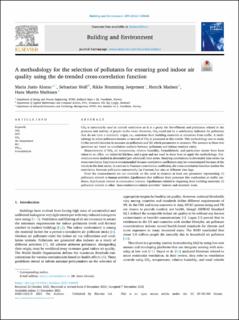| dc.description.abstract | CO2 is customarily used to control ventilation as it is a proxy for bio-effluents and pollutants related to the presence and activity of people in the room. However, CO2 could not be a satisfactory indicator for pollutants that do not have a metabolic origin, i.e., emissions from building materials or emissions from traffic. A methodology to select pollutants besides or instead of CO2 is presented in this article. This methodology sets to study (i) the suitable location to measure air pollutants and (ii) which parameters to measure. The answers to these two questions are based on correlation analysis between pollutants and indoor/outdoor ratios.
Measurements of CO2, air temperature, relative humidity, formaldehyde, and particulate matter have been taken in an office, an industrial kitchen, and a gym and are used to show how to apply the methodology. Correlations were studied in detrended (pre-whitened) time series. Studying correlations in detrended time series via cross-correlation functions is recommended because correlation coefficients may be overestimated because of the trends in the time series. In contrast to Pearson's correlation coefficient, the cross-correlation function studies the correlation between pollutants concurrently (as Pearson) but also at different time lags.
From the measurements we can conclude on the need to measure at least one parameter representing: 1)pollutants related to human activities 2)pollutants that infiltrate from processes like combustion or traffic outdoors, 3)pollutants related to combustion indoors, 4)pollutants related to degassing from building materials, 5)pollutants related to other “non-combustion-related activities” indoors and moisture loads. | en_US |

